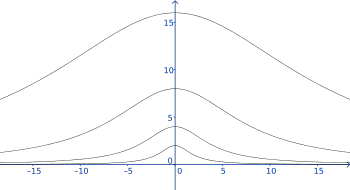Witch of Agnesi
In mathematics, the Witch of Agnesi (Italian pronunciation: [a.ˈɲe.zi]), sometimes called the "Witch of Maria Agnesi" is the curve defined as follows.

Starting with a fixed circle, a point O on the circle is chosen. For any other point A on the circle, the secant line OA is drawn. The point M is diametrically opposite to O. The line OA intersects the tangent of M at the point N. The line parallel to OM through N, and the line perpendicular to OM through A intersect at P. As the point A is varied, the path of P is the Witch of Agnesi.
The curve is asymptotic to the line tangent to the fixed circle through the point O.
Equations

Suppose the point O is the origin, and that M is on the positive y-axis. Suppose the radius of the circle is a.
Then the curve has Cartesian equation
Note that if a = 1/2, then this equation becomes rather simple:
This is the derivative of the arctangent function.
Parametrically, if is the angle between OM and OA, measured clockwise, then the curve is defined by the equations
Another parameterization, with being the angle between OA and the x-axis, increasing anti-clockwise is
Properties

The following properties can be derived from integral calculus.
- The area between the witch and the asymptote at O is four times the area of the fixed circle (i.e., ).
- The centroid of this region is ill-defined, as the first moment with respect to x is ill-defined.[1]
- The centroid of the generating circle (diameter = 2a) is located at .
- The volume of revolution of the Witch of Agnesi, about its asymptote, is .
History
The curve was studied by Pierre de Fermat in 1630. In 1703, Guido Grandi gave a construction for the curve. In 1718 Grandi suggested the name 'versoria' for the curve, the Latin term for sheet, the rope which turns the sail, and used the Italian word for it, 'versiera', a hint to sinus versus that appeared in his construction.[2]
In 1748, Maria Gaetana Agnesi published her summation treatise Instituzioni analitiche ad uso della gioventù italiana, in which the curve was named according to Grandi, 'Versiera'.[2] Coincidentally, the contemporary Italian word 'avversiera' or 'versiera', derived from Latin 'Adversarius', a nickname for Devil, "Adversary of God", was synonymous with "witch".[3] Cambridge professor John Colson mistranslated the name of the curve thus. Different modern works about Agnesi and about the curve suggest slightly different guesses how exactly this mistranslation happened.[4][5][6] Struik mentions that:
The word [versiera] is derived from Latin vertere, to turn, but is also an abbreviation of Italian avversiera, female devil. Some wit in England once translated it 'witch', and the silly pun is still lovingly preserved in most of our textbooks in English language. ... The curve had already appeared in the writings of Fermat (Oeuvres, I, 279–280; III, 233–234) and of others; the name versiera is from Guido Grandi (Quadratura circuli et hyperbolae, Pisa, 1703). The curve is type 63 in Newton's classification. ... The first to use the term 'witch' in this sense may have been B. Williamson, Integral calculus, 7 (1875), 173;[7] see Oxford English Dictionary.
On the other hand, Stephen Stigler suggests that Grandi himself "may have been indulging in a play on words".[8]
The Witch of Agnesi is also a fiction novel by Robert Spiller, in which a teacher gives a version of the history of the term.[9]
Application
The witch of Agnesi approximates the spectral energy distribution of spectral lines, particularly x-ray lines.[10]
Formally, the curve is equivalent to the probability density function of the Cauchy distribution.
The cross-section of a smooth hill also has a similar shape. It has been used as the generic topographic obstacle in a flow in mathematical modeling.[11] [12]
See also
Notes
- ↑ "Cauchy Distribution". University of Alabama at Huntsville. Retrieved September 12, 2014.
- 1 2 Truesdell, C. (1991). "Correction and Additions for "Maria Gaetana Agnesi"". Archive for History of Exact Science. 43 (4). pp. 385–386. doi:10.1007/BF00374764.
[…] nata da' seni versi, che da me suole chiamarsi la Versiera in latino però Versoria […]
- ↑ Pietro Fanfani, Vocabolario dell'uso toscano, p. 334
- ↑ Women in Mathematics By Lynn M. Osen (1975) p. 45
- ↑ "Fermat's Enigma" by Simon Singh p. 100
- ↑ The universal book of mathematics: from Abracadabra to Zeno's paradoxes By David J. Darling (2004) p. 8
- ↑ "173 Find the area between the witch of Agnesi and its asymptote." (Oxford English Dictionary)
- ↑ S. M. Stigler, "Cauchy and the Witch of Agnesi: An historical note on the Cauchy distribution", Biometrika, 1974, vol. 61, no. 2 pp. 375–380
- ↑ Spiller, Robert (2006). The Witch of Agnesi. Palm Beach, FL: Medallion Press. ISBN 978-1-932815-72-6. OCLC 71259167.
- ↑ Spencer, Roy C. (1940). "Properties of the Witch of Agnesi—Application to Fitting the Shapes of Spectral Lines". Journal of the Optical Society of America. 30 (9): 415–419.
- ↑ Snyder, William H.; et al. "The structure of strongly stratified flow over hills: dividing-streamline concept" (PDF). J. Fluid Mech. 152: 249–288. doi:10.1017/s0022112085000684. Retrieved 12 January 2014.
- ↑ Lamb, Kevin G. "Numerical simulations of stratified inviscid flowover a smooth obstacle" (PDF). J. Fluid Mech. 260: 1–22. doi:10.1017/s0022112094003411. Retrieved 12 January 2014.
References
| Wikisource has the text of the 1911 Encyclopædia Britannica article Witch of Agnesi. |
- "Witch of Agnesi" at MacTutor's Famous Curves Index
- "Cubique d'Agnesi" at Encyclopédie des Formes Mathématiques Remarquables (French)
- "MacTutor biography of Agnesi".
- John H. Lienhard (2002). The Engines of Our Ingenuity. Episode 1741. The Witch of Agnesi. NPR. KUHF-FM Houston.
External links
| Wikimedia Commons has media related to Witch of Agnesi. |
- Witch of Agnesi by Chris Boucher based on work by Eric W. Weisstein, The Wolfram Demonstrations Project.
- The Witch of Agnesi – Mathforum.org Java applet